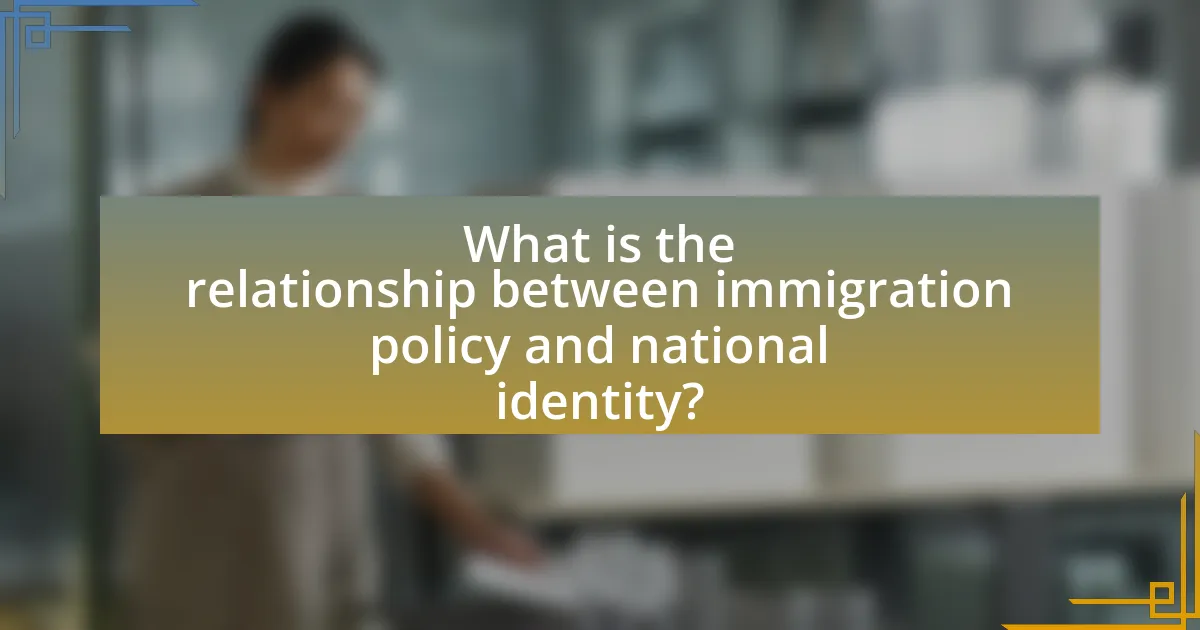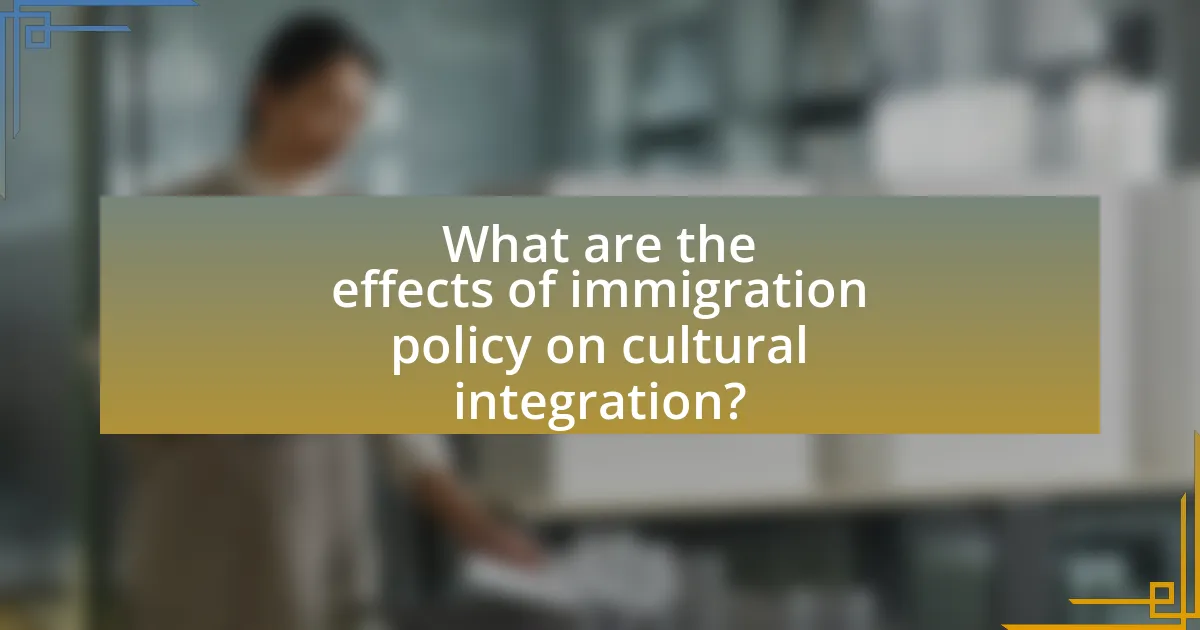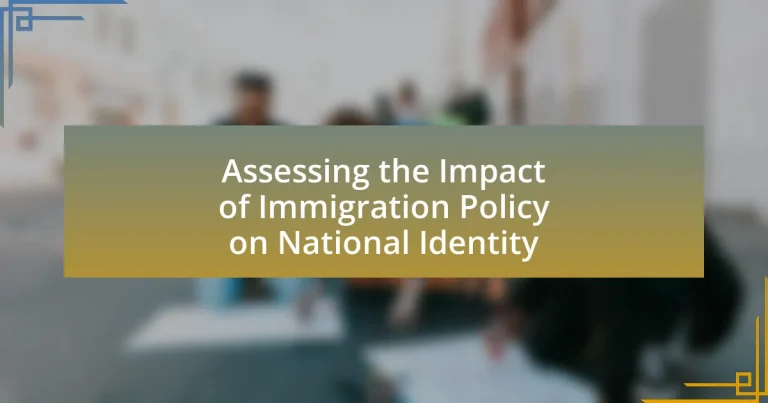The article examines the relationship between immigration policy and national identity, highlighting how policies shape demographic composition and cultural values within nations. It discusses the impact of historical contexts on current immigration frameworks, the varying definitions of national identity across different countries, and the significance of national identity in fostering social cohesion. Additionally, the article explores how immigration policies can either reinforce or challenge national identity, the effects on cultural integration and diversity, and the implications of multiculturalism. Key metrics for assessing the impact of immigration policy on national identity are also outlined, along with best practices for aligning policies with national identity and enhancing community engagement.

What is the relationship between immigration policy and national identity?
Immigration policy directly influences national identity by shaping the demographic composition and cultural values of a nation. Policies that favor certain groups can reinforce a specific national identity, while inclusive policies may promote a more diverse identity. For example, the Immigration and Nationality Act of 1965 in the United States shifted the demographic landscape by ending racial quotas, leading to increased diversity and a broader national identity that reflects multiculturalism. This relationship is evident in how nations define citizenship, cultural integration, and social cohesion, impacting both the perception of national identity and the lived experiences of immigrants.
How do immigration policies shape perceptions of national identity?
Immigration policies significantly shape perceptions of national identity by defining who is considered a member of the nation and influencing societal attitudes towards diversity. For instance, restrictive immigration policies often foster a perception of national identity that prioritizes homogeneity, leading to increased nationalism and xenophobia. Conversely, inclusive immigration policies can promote a more multicultural identity, encouraging acceptance and integration of diverse groups. Research by the Pew Research Center indicates that countries with more welcoming immigration policies tend to have populations that view immigrants positively, thereby reinforcing a broader, more inclusive national identity.
What are the historical contexts influencing current immigration policies?
Historical contexts influencing current immigration policies include colonialism, economic migration patterns, and significant legislative acts. Colonialism established early migration trends, as European powers expanded their territories, leading to the movement of people across continents. Economic migration patterns emerged during the Industrial Revolution, where labor shortages prompted countries to attract foreign workers, shaping policies to facilitate this influx. Significant legislative acts, such as the Immigration and Nationality Act of 1965 in the United States, redefined immigration criteria, moving away from race-based quotas to family reunification and skilled labor preferences, which continue to influence contemporary immigration frameworks. These historical factors collectively inform the current landscape of immigration policies, reflecting a complex interplay of past events and societal needs.
How do different countries define national identity in relation to immigration?
Different countries define national identity in relation to immigration through varying criteria, including cultural, legal, and historical factors. For instance, France emphasizes a civic model of national identity, where citizenship is based on principles of liberty, equality, and fraternity, allowing for integration of immigrants regardless of their ethnic background. In contrast, Japan adopts an ethnic model, prioritizing homogeneity and cultural continuity, which often results in stricter immigration policies and a more exclusionary approach to national identity. The United States, meanwhile, embodies a pluralistic identity, promoting the idea of a “melting pot” where diverse immigrant backgrounds contribute to a shared national culture. These definitions are influenced by historical contexts, such as colonial legacies in Canada and Australia, which shape contemporary immigration policies and national identity perceptions.
Why is national identity important in the context of immigration?
National identity is important in the context of immigration because it shapes the social cohesion and cultural integration of diverse populations within a nation. A strong national identity fosters a sense of belonging among citizens and immigrants, which can lead to increased social stability and mutual respect. For instance, research by the Pew Research Center indicates that countries with a well-defined national identity often experience smoother integration processes for immigrants, as shared values and cultural norms facilitate communication and understanding. This integration is crucial for maintaining social harmony and reducing tensions that may arise from cultural differences.
What role does national identity play in social cohesion?
National identity plays a crucial role in fostering social cohesion by creating a shared sense of belonging among individuals within a society. This shared identity promotes unity and collective values, which are essential for social stability. Research indicates that societies with a strong national identity tend to exhibit lower levels of social fragmentation and higher levels of trust among citizens. For instance, a study by the Pew Research Center found that countries with a pronounced national identity, such as Japan and Canada, report higher levels of social trust and community engagement compared to those with weaker national identities. This evidence underscores the importance of national identity in enhancing social cohesion and mitigating divisions within diverse populations.
How can immigration policies reinforce or challenge national identity?
Immigration policies can reinforce national identity by promoting cultural assimilation and shared values among immigrants, while they can challenge national identity by fostering multiculturalism and diversity that may lead to tensions. For instance, policies that prioritize language acquisition and civic education encourage immigrants to adopt the host country’s cultural norms, thereby strengthening a unified national identity. Conversely, policies that allow for high levels of immigration from diverse backgrounds can introduce varying cultural practices and beliefs, which may create a sense of division or challenge the traditional notions of national identity. Historical examples include the U.S. Immigration Act of 1924, which aimed to preserve a specific national identity by restricting immigration from certain countries, and more recent debates surrounding immigration reform that highlight the tension between inclusivity and national cohesion.

What are the effects of immigration policy on cultural integration?
Immigration policy significantly influences cultural integration by shaping the conditions under which immigrants can assimilate into society. Policies that promote inclusivity, such as pathways to citizenship and access to language education, facilitate smoother integration and foster multiculturalism. Conversely, restrictive immigration policies can lead to social fragmentation and hinder the ability of immigrants to participate fully in cultural and civic life. For instance, a study by the Migration Policy Institute found that countries with more welcoming immigration policies tend to experience higher rates of cultural exchange and community cohesion, demonstrating the direct correlation between policy and integration outcomes.
How do immigration policies affect cultural diversity within a nation?
Immigration policies significantly shape cultural diversity within a nation by determining the flow and composition of immigrant populations. For instance, policies that favor family reunification or skilled labor can lead to a more diverse cultural landscape, as they attract individuals from various backgrounds and countries. In contrast, restrictive immigration policies may limit the influx of diverse cultures, leading to a more homogenous society. Research indicates that countries with inclusive immigration policies, such as Canada, experience higher levels of cultural diversity, with over 20% of the population being foreign-born, compared to nations with stringent policies, which often see lower diversity levels. This correlation underscores the direct impact of immigration policies on the cultural fabric of a nation.
What are the implications of multiculturalism on national identity?
Multiculturalism significantly influences national identity by promoting a more inclusive and diverse understanding of what it means to belong to a nation. This shift often leads to the redefinition of national identity, where multiple cultural narratives coexist, challenging the traditional, homogeneous notions of identity. For instance, countries like Canada and Australia have embraced multicultural policies that celebrate diversity, resulting in a national identity that reflects various cultural heritages rather than a singular, dominant culture. Research indicates that such policies can enhance social cohesion and economic growth by fostering an environment where diverse perspectives contribute to innovation and community development.
How do policies promote or hinder cultural exchange?
Policies can promote cultural exchange by facilitating immigration and encouraging multiculturalism, while they can hinder it by imposing restrictive measures that limit the movement of people and ideas. For instance, countries with open immigration policies, such as Canada, actively promote cultural exchange through programs that support diversity and inclusion, leading to a richer cultural landscape. Conversely, restrictive immigration policies, like those seen in some European nations, can create barriers that isolate communities and reduce opportunities for cultural interaction, as evidenced by the decline in cultural festivals and exchanges in areas with stringent immigration controls.
What challenges arise from immigration policies regarding cultural integration?
Immigration policies often create challenges for cultural integration by imposing restrictions that can hinder social cohesion. These policies may lead to segregation, as immigrants might be forced into specific neighborhoods or communities, limiting their interactions with the broader society. For instance, research from the Pew Research Center indicates that restrictive immigration laws can exacerbate feelings of alienation among immigrant populations, making it difficult for them to assimilate and participate fully in the cultural life of their new country. Additionally, language barriers and differing cultural norms can further complicate integration efforts, as immigrants may struggle to communicate and engage with local customs. This lack of integration can result in social tensions and a fragmented national identity, as highlighted by studies showing that communities with higher immigrant populations often experience increased polarization when immigration policies are perceived as exclusionary.
How do restrictive immigration policies impact community relations?
Restrictive immigration policies negatively impact community relations by fostering division and mistrust among residents. These policies often lead to increased fear and anxiety within immigrant communities, which can result in social isolation and reduced participation in community activities. For instance, a study by the American Immigration Council found that communities with strict immigration enforcement experience heightened tensions between immigrant and non-immigrant populations, leading to a breakdown in social cohesion. Additionally, restrictive policies can create an environment where discrimination and xenophobia thrive, further alienating immigrants and undermining community solidarity.
What are the consequences of cultural assimilation versus multiculturalism?
Cultural assimilation leads to the dominance of one culture over others, often resulting in the loss of minority cultural identities, while multiculturalism promotes the coexistence of diverse cultures, fostering mutual respect and cultural exchange. The consequences of cultural assimilation can include social fragmentation, resentment among minority groups, and a homogenized national identity that may overlook the contributions of various cultures. In contrast, multiculturalism can enhance social cohesion, economic innovation, and a richer national identity by integrating diverse perspectives and practices. Studies, such as those by the Pew Research Center, indicate that countries embracing multicultural policies tend to experience lower levels of social tension and higher levels of civic engagement compared to those that prioritize assimilation.

How can immigration policy be assessed for its impact on national identity?
Immigration policy can be assessed for its impact on national identity by analyzing demographic changes, cultural integration, and public sentiment. Demographic changes, such as shifts in population composition due to immigration, can reveal how new groups influence national identity. For instance, the U.S. Census Bureau reported that by 2045, non-Hispanic whites are projected to become a minority, indicating a significant transformation in national identity. Cultural integration can be evaluated through the participation of immigrants in civic life, education, and the workforce, which can either enhance or dilute traditional national values. Public sentiment, measured through surveys and studies, reflects how citizens perceive the influence of immigration on their national identity. Research by the Pew Research Center shows that attitudes toward immigration can vary widely, affecting the collective sense of identity within a nation.
What metrics can be used to evaluate the impact of immigration policy?
Metrics used to evaluate the impact of immigration policy include economic indicators, demographic changes, social integration measures, and public opinion surveys. Economic indicators such as GDP growth, employment rates, and tax contributions provide insights into the economic effects of immigration. Demographic changes, including population diversity and migration patterns, help assess shifts in national identity. Social integration measures, such as language proficiency and participation in civic activities, evaluate how well immigrants assimilate into society. Public opinion surveys gauge societal attitudes towards immigration and its perceived impact on national identity. These metrics collectively offer a comprehensive framework for understanding the multifaceted effects of immigration policy.
How do public opinion surveys reflect changes in national identity?
Public opinion surveys reflect changes in national identity by capturing shifts in attitudes, beliefs, and values among the population. These surveys provide quantitative data that reveal how individuals perceive their national identity in relation to factors such as immigration, cultural diversity, and social integration. For instance, a Pew Research Center study in 2020 indicated that 62% of Americans felt that immigrants strengthen the country, a significant increase from previous years, highlighting a shift towards a more inclusive national identity. This data illustrates how public sentiment evolves in response to immigration policies and societal changes, thereby serving as a barometer for national identity transformation.
What role do academic studies play in assessing immigration policy impacts?
Academic studies play a crucial role in assessing immigration policy impacts by providing empirical evidence and analytical frameworks that evaluate the social, economic, and cultural effects of such policies. These studies utilize quantitative data, such as employment rates and demographic changes, alongside qualitative research, including interviews and case studies, to offer a comprehensive understanding of how immigration policies influence national identity. For instance, research published in the “Journal of Migration Studies” by authors like Portes and Rumbaut demonstrates that immigration can reshape cultural norms and community dynamics, thereby affecting national identity perceptions. This evidence-based approach allows policymakers to make informed decisions that consider the multifaceted implications of immigration on society.
What best practices can be implemented to align immigration policy with national identity?
Best practices to align immigration policy with national identity include promoting civic integration programs, establishing clear pathways for citizenship, and fostering community engagement initiatives. Civic integration programs, such as language and cultural education, help immigrants understand and embrace the national identity, as evidenced by successful models in countries like Canada, where newcomers are encouraged to participate in local customs and values. Clear pathways for citizenship, which often include residency requirements and knowledge of national history, ensure that immigrants are invested in the nation’s future, as seen in the naturalization processes of countries like Germany. Community engagement initiatives, such as local mentorship programs and cultural exchange events, facilitate connections between immigrants and native citizens, enhancing social cohesion and mutual understanding, as demonstrated by various successful integration efforts in cities like Melbourne.
How can policymakers engage communities in shaping immigration policies?
Policymakers can engage communities in shaping immigration policies by facilitating inclusive dialogues and participatory processes that allow community members to voice their concerns and suggestions. For instance, town hall meetings, focus groups, and surveys can be organized to gather input from diverse community stakeholders, ensuring that the policies reflect the needs and values of the population. Research shows that when communities are actively involved in policy discussions, the resulting immigration policies are more likely to gain public support and effectively address local challenges, as evidenced by the successful implementation of community-driven initiatives in cities like San Francisco and New York.
What strategies can enhance the positive effects of immigration on national identity?
Strategies that can enhance the positive effects of immigration on national identity include promoting inclusive policies, fostering intercultural dialogue, and implementing community integration programs. Inclusive policies, such as pathways to citizenship and anti-discrimination laws, ensure that immigrants feel valued and recognized within the national framework, which can strengthen their connection to national identity. Fostering intercultural dialogue through educational initiatives and public forums allows for the exchange of cultural values and traditions, promoting mutual understanding and respect among diverse groups. Community integration programs, such as language classes and job training, facilitate immigrants’ adaptation and participation in society, further reinforcing their sense of belonging and contribution to the national identity. Research indicates that countries with strong integration policies, like Canada, experience higher levels of social cohesion and national pride among both immigrants and native citizens.
What are the key takeaways for understanding the impact of immigration policy on national identity?
The key takeaways for understanding the impact of immigration policy on national identity include the recognition that immigration policies shape societal perceptions of belonging and citizenship. These policies can either promote inclusivity or foster division, influencing how immigrants are integrated into the national fabric. For instance, restrictive immigration policies often lead to a perception of immigrants as outsiders, which can undermine social cohesion and national identity. Conversely, inclusive policies that facilitate integration can enhance national identity by embracing diversity and promoting shared values. Research indicates that countries with more welcoming immigration policies tend to experience stronger social cohesion and a more robust national identity, as seen in nations like Canada and Sweden, where multiculturalism is a core component of national identity.


